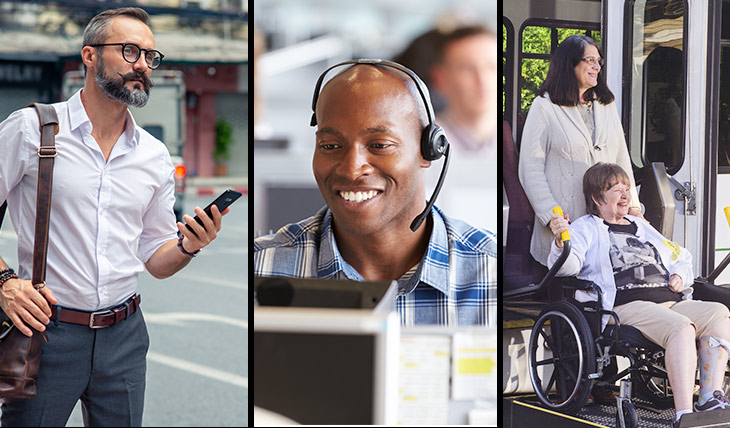Microtransit, First Mile / Last Mile, On-Demand & More – Digging into Demand Response Transit Software

As a writer, who's been in the word game for a while, I was thinking about how terminology/lingo (in all industries) continually evolves. When I started my career writing marketing ads for an agency in the 90's, my work was referred to as “copy”. Today, “content” is king of the terminology heap.
The transportation technology business is no different. At TripSpark Technologies, where I work as a content specialist, we create cool tech solutions that our transit customers use to keep their riders safe and happy. One of our awesome passenger apps is called Rides on Demand. It's part of our “demand response” family of products. And while demand response is not a new concept, the term can be confusing. It is also often intertwined with other terms like “microtransit“, “first mile/last mile”, “paratransit”, “dial-a-ride” and, “mobility on demand” – oh, and let's not forget “deviated fixed route transit”.
Demand Response Services by Definition
Transportation types and terms are often referred to interchangeably because they are each a type of on-demand, often dynamically routed transit service, but with slight variations, depending on how they serve the needs of their users (aka riders/passengers/travelers, etc. etc.). Let's take a closer look at each term to better understand its distinction.
What is Demand Response?
Simply, “demand response” refers to any non-fixed route system of transporting individuals. It has historically required advanced scheduling by the customer, including services provided by public entities, nonprofits, and private providers. These vehicles typically pick-up and drop-off passengers in locations according to needs.
What is Microtransit?
Microtransit can mean many things and have many descriptions (mobility on demand, flexible transit, on demand transportation) but in general, microtransit typically fits somewhere between private individual transportation (cars, taxicabs or TNCs) and public mass transit (buses). It’s a form of shared mobility with “curb-to-curb” or “stop-to-stop” service, whereby riders travelling in the same general direction are picked up along the way. Transit agencies are increasingly implementing microtransit solutions to increase service coverage and/or hours, and improve their riders' experience.
What is First Mile/Last Mile?
Sometimes called “home-to-hub”, first and last-mile connections describe the beginning or end of an individual trip, enabling riders to travel on mass transportation like buses and trains. In many cases, people will walk to transit if it is close enough. However, on either end of a public transit trip, the origin or destination may be difficult or impossible to access by a short walk. Several transit agencies have implemented microtransit to provide first mile/last mile service and, as a result, they have seen an overall increase in mass transit ridership.
What is Dial-a-Ride Transit (DART)?
Some refer to dial-a-ride transit as the origin of microtransit. Simply, DART is a method where riders pick up the phone to book their transportation. These individuals either cannot use fixed route transit or they do not have fixed route service accessibility. DART is perfect for those who just want to talk to a “real live human” and not struggle with technology. However, the challenge with DART is that riders typically must book travel at least a day in advance and place a call to their transit agency during business hours. This limits their control and flexibility. For those who want more control, apps like Passenger Portal and Rides on Demand, allow riders to book their own travel any time of day, and it takes the burden off agency call takers.
What is Deviated Fixed Route?
Deviated fixed route is a form of flexible on-demand transit, that will deviate by request (or on demand). It operates along a fixed route, and generally at fixed times, but has slack built into the schedule to allow the vehicle to deviate to drop off passengers who have requested a deviation. Deviated fixed route service is typically an ADA service (within a ¾ mile radius), but agencies don’t always limit it to that. For example, in many small communities, drivers will deviate to take a rider with a load of groceries home or sometimes vehicles will only go down certain parts of a route to accommodate a passenger need. In TripSpark's Novus, agencies can use friendly fixed route functionality. If a rider wants to request a deviation, they either call the agency or just ask the driver.
What is Mobility on Demand?
Mobility on Demand (MOD) as defined by the Federal Transit Administration, is the term for “an integrated and connected multi-modal network of safe, affordable, and reliable transportation options that are available to all”. The term MaaS (Mobility as a Service) is often used interchangeably with MOD, however there are some differences (but we’ll leave that for another day). MOD combines traditional public transportation with private enterprise options, such as ride hailing and bike sharing, into a single mobility service. MOD is traveler-focused, putting more weight on personal choice, trip satisfaction and the efficient delivery of services. Combining all these mobility services, fills gaps in the current transportation offerings to allow true, complete point-to-point trips for everyone.
Finally … What is Paratransit?
Paratransit is the term used in North America, for transportation services that supplement fixed-route mass transit by providing transportation for those who cannot ride conventional transit. Sometimes known as “complementary ADA” or “specialized transit”, paratransit typically takes the form of demand response services.
And for a little history on paratransit… It first emerged in response to the Federal Rehabilitation Act of 1973, which required transportation agencies that receive federal funding to either make their systems accessible to disabled persons or provide complementary mobility services. Most agencies opted for the complementary services, as it was the less expensive option. In 1990, the Americans with Disabilities Act (ADA) expanded this mandate to all public transportation systems, regardless of their funding sources. It also required any new public transit projects to be accessible to individuals with disabilities, while also mandating complementary mobility services for destinations that fell within ¾ miles of all existing routes.
Paratransit is not quite like the others
Paratransit is extremely crucial to those that rely on it; however it is a costly service to provide when compared to fixed route. Many transit agencies screen riders to ensure they meet certain eligibility criteria to be able to use paratransit services. Agencies also must determine if riders are eligible to utilize paratransit services all the time or only under certain circumstances (i.e., conditional eligibility). Where eligibility is a challenge, other on-demand transit services such as microtransit, first mile/last mile and deviated fixed route, can alleviate the demand for paratransit services. The good news is that there are some funding programs that cover (or partially cover) on-demand transportation, and transit agencies are paid for those rides that are covered. Paratransit is particularly unique and complex in that not all riders have the same needs. Some riders have unique space requirements – say he or she has an extra-large, motorized wheelchair, for example, and a special vehicle is required. Or, there may be riders that require extra time and assistance to board vehicles and oftentimes, there are riders who cannot ride on certain vehicles, or with certain drivers. Adding further complexity, conditions around trip purpose and travel location are applied. For these reasons and more, it’s important to have a software solution that can easily manage all of these paratransit complexities.
Convenience is key
Above all, booking travel must be convenient, not only for paratransit and other riders, but also for transit agencies. Take for instance trips where a group of passengers travel to the same destination on a weekly basis. Booking a standing weekly trip for the group versus numerous individual trips can save hours of effort. Providing riders with a portal to book their own travel any time of day or night means that those that don’t feel comfortable with or have access to technology aren’t waiting on hold to speak with booking agents. Those non-tech riders also have the option to have someone manage travel on their behalf using the online portal, whether it be family, a staff member or another authorized delegate. Software solutions that offer flexibility and options are key to providing convenience and independence.
Recognizing that not everyone can call an Lyft or jump into a friend’s vehicle to get to that critical dialysis (or other) appointment, some transit agencies that offer on-demand service to the entire public, choose to prioritize their paratransit riders. It is important to have an on-demand software solution that supports prioritizing paratransit riders, whether providing door-to-door service for those that can’t walk to a virtual stop, expanded service areas, extended booking windows or prioritizing paratransit trips when scheduling rides.
A solution as the solution
Every agency has unique needs and priorities. Some agencies make paratransit riders their focus over the general public. And to fulfil this mandate most effectively, they can implement a single source demand response software solution. With the right “solution” agencies can make paratransit trips a priority over fixed route trips. Special considerations like, allowing for longer booking windows and giving family members and care givers access to paratransit rider trips through passenger portal, make booking travel easy and stress-free. Given that the current state of the transit industry (and most other industries, for that matter), transit agencies are continuing to alter and expand their service options to keep their riders safe and happy, and to keep their businesses sustainable. Whatever an agency's priorities and business goals, the right solution can go a long way to make this happen.
Enjoy the ride
It's clear that there are many demand response transit service options for riders, and amazing software solutions for agencies to support those services. No matter the service option selected or how it is labelled, each comes with its own set of enjoyable benefits for agencies and their riders.

